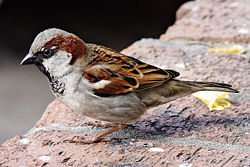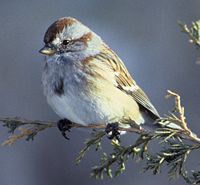Sparrow
 From Nwe
From Nwe
Sparrow is the common name for various small passerine (perching) birds applied either to various members of the Old World family Passeridae ("true sparrows") or the American sparrows, or New World sparrows, within the family Emberizidae. (In some classifications, the American sparrows are placed within the finch family Fringillidae.) The American sparrows are not closely related to the true sparrows, despite some physical resemblance, such as the seed-eater's bill and frequently well-marked heads.
The sparrows, with their unique forms, behaviors, and songs, add an important component to the joy that humans feel in experiencing nature. In the original sense of the term as any small bird, the sparrow also appears in the New Testament of the Bible as an apt metaphor for the importance that God places on human beings. Jesus reassures his followers that even a sparrow cannot fall without God's notice (Luke 12:6; Mathew 10:29), telling them "Do not fear therefore; you are of more value than many sparrows."
Classification and description
Sparrows, whether the term is used for the Old World birds or the New World species, belong to the order Passeriformes, the largest order of birds, with more than half of all species. The passerines are true perching birds, being specialized for holding onto a branch, with three toes directed forward without any webbing or joining, and one toe directed backward. In other orders of birds, the toe arrangement is different. The order includes such birds as finches, warblers, and jays. The group gets its name from the Latin name for the house sparrow, Passer domesticus. Passerines are all terrestrial, found on all continents except Antarctica. Most passerines lay colored eggs, in contrast to non-passerines, where the color generally is white, with some exceptions.
Sparrows belong to the passerine suborder Passeri, and thus are known as "songbirds" or "oscines." In the oscines, the vocal organ is developed in such a way as to produce various sound notes, commonly known as bird song. Oscines have the most control of their syrinx muscles among birds, producing a wide range of songs and other vocalizations (though some of them, such as the crows, do not sound like it, while others like the Lyrebird are accomplished imitators). Besides the sparrows, song birds include lyrebirds, blackbirds, jays, larks, warblers, finches, wrens, starlings, and cowbirds.
Within the Passeri and superfamily Passeroidea, there are various families, two of which are Passeridae (true sparrows) and Emberizidae (buntings and American sparrows). The American sparrows, which are not closely related to the Old World sparrows, have habits similar to those of finches, which comprise the family Fringillidae within the same superfamily. Older sources may place some emberizids in the Fringillidae (traditionally grouped as the subfamily Emberizinae), and the common names of some emberizids still refer to them as finches.
The Hedge Sparrow or Dunnock (Prunella modularis) is unrelated to either group, being in the passerine family Prunellidae. It is a sparrow in name only, a relic of the old practice of calling any small bird a "sparrow."
Old World sparrows
| Old World sparrows | ||||||||||
|---|---|---|---|---|---|---|---|---|---|---|

House Sparrow
|
||||||||||
| Scientific classification | ||||||||||
|
||||||||||
|
|
||||||||||
Passer |
The true sparrows, the Old World sparrows in the family Passeridae, are small passerine birds. Generally, sparrows tend to be small, plump brown-gray birds with short tails and stubby yet powerful beaks. The differences between sparrow species can be subtle. They are primarily seed-eaters, though they also consume small insects. A few species scavenge for food around cities and, like gulls or rock pigeons, will happily eat virtually anything in small quantities. This family ranges in size from the Chestnut Sparrow (Passer eminibey), at 11.4 cm (4.5 inches) and 13.4 g., to the Parrot-billed Sparrow (Passer gongonensis), at 18 cm (7 inches) and 42 g. (1.5 oz).
The Old World true sparrows are found indigenously in Europe, Africa, and Asia. In Australia and the Americas, early settlers imported some species, which quickly naturalized, particularly in urban and degraded areas. House sparrows (Passer domesticus), for example, are now found throughout North America, in every state of Australia except Western Australia, and over much of the heavily populated parts of South America. House sparrows were misnamed English sparrows, to distinguish them from native fauna, but are not particularly a native of England (Zim and Gabrielson 1956).
Some authorities also classify the closely related estrildid finches of the equatorial regions and Australasia as members of the Passeridae. Like the true sparrows, the estrildid finches are small, gregarious, and often colonial seed-eaters with short, thick, but pointed bills. They are broadly similar in structure and habits, but tend to be very colorful and vary greatly in their plumage. About 140 species are native to the Old World tropics and Australasia. Most taxonomic schemes list the estrildid finches as the separate family Estrildidae, leaving just the true sparrows in Passeridae.
Species of Old World sparrows
There are 35 species of Old World sparrows. Below is the full list.
- Passer, the true sparrows
- Saxaul Sparrow, Passer ammodendri
- House Sparrow, Passer domesticus
- Spanish Sparrow, Passer hispaniolensis
- Sind Sparrow, Passer pyrrhonotus
- Somali Sparrow, Passer castanopterus
- Cinnamon Sparrow or Russet Sparrow, Passer rutilans
- Pegu Sparrow or Plain-backed Sparrow, Passer flaveolus
- Dead Sea Sparrow, Passer moabiticus
- Rufous Sparrow, Passer motitensis
- Socotra Sparrow, Passer insularis
- Iago Sparrow or Cape Verde Sparrow, Passer iagoensis
- Cape Sparrow or Mossie, Passer melanurus
- Grey-headed Sparrow, Passer griseus
- Swainson's Sparrow, Passer swainsonii
- Parrot-billed Sparrow, Passer gongonensis
- Swahili Sparrow, Passer suahelicus
- Southern Grey-headed Sparrow, Passer diffusus
- Desert Sparrow, Passer simplex
- Tree Sparrow, Passer montanus
- Sudan Golden Sparrow, Passer luteus
- Arabian Golden Sparrow, Passer euchlorus
- Chestnut Sparrow, Passer eminibey
- Italian Sparrow, Passer italiae
- Kenya Rufous Sparrow, Passer rufocinctus
- Kordofan Rufous Sparrow, Passer cordofanicus
- Shelley's Rufous Sparrow, Passer shelleyi
- Asian Desert Sparrow, Passer zarudnyi
- Petronia, the rock sparrows
- Yellow-spotted Petronia, Petronia pyrgita
- Chestnut-shouldered Petronia, Petronia xanthocollis
- Yellow-throated Petronia, Petronia superciliaris
- Bush Petronia, Petronia dentata
- Rock Sparrow, Petronia petronia
- Carpospiza, Pale Rockfinch
- Pale Rockfinch, Carpospiza brachydactyla
- Montifringilla, the snowfinches
- White-winged Snowfinch, Montifringilla nivalis
- Black-winged Snowfinch, Montifringilla adamsi
- White-rumped Snowfinch, Montifringilla taczanowskii
- Père David's Snowfinch, Montifringilla davidiana
- Rufous-necked Snowfinch, Montifringilla ruficollis
- Blanford's Snowfinch, Montifringilla blanfordi
- Afghan Snowfinch, Montifringilla theresae
- Tibetan Snowfinch, Montifringilla henrici
American sparrows or New World sparrows
| American Sparrows | ||||||||||
|---|---|---|---|---|---|---|---|---|---|---|

American Tree Sparrow
|
||||||||||
| Scientific classification | ||||||||||
|
||||||||||
|
|
||||||||||
see text |
American sparrows are a group of mainly New World passerine birds, forming part of the family Emberizidae. American sparrows are seed-eating birds with conical bills, brown or gray in color, and many species have distinctive head patterns.
Although they share the name sparrow, American sparrows are more closely related to Old World buntings (family Emberizidae) than they are to the Old World sparrows (family Passeridae). American sparrows are also similar in both appearance and habit to finches, with which they sometimes used to be classified.
Species of American sparrows
Genus Arremon
- Orange-billed Sparrow, Arremon aurantiirostris
- Pectoral Sparrow, Arremon taciturnus
- San Francisco Sparrow, Arremon franciscanus
- Half-collared Sparrow, Arremon semitorquatus
- Golden-winged Sparrow, Arremon schlegeli
- Black-capped Sparrow, Arremon abeillei
- Saffron-billed Sparrow, Arremon flavirostris
Genus Arremonops
- Olive Sparrow, Arremonops rufivirgatus
- Tocuyo Sparrow, Arremonops tocuyensis
- Green-backed Sparrow, Arremonops chloronotus
- Black-striped Sparrow, Arremonops conirostris
Genus Melozone
- Rusty-crowned Ground-Sparrow, Melozone kieneri
- Prevost's Ground-Sparrow, Melozone biarcuatum
- White-eared Ground-Sparrow, Melozone leucotis
Genus Pipilo
- Green-tailed Towhee, Pipilo chlorurus
- Collared Towhee, Pipilo ocai
- Rufous-sided Towhees:
- Eastern Towhee, Pipilo erythrophthalmus
- Spotted Towhee, Pipilo maculatus
- Olive-backed Towhee, Pipilo maculatus macronyx
- Socorro Towhee, Pipilo socorroensis
- Brown Towhees:
- California Towhee, Pipilo crissalis
- Canyon Towhee, Pipilo fuscus
- Abert's Towhee, Pipilo aberti
- White-throated Towhee, Pipilo albicollis
Genus Aimophila
- Bridled Sparrow, Aimophila mystacalis
- Black-chested Sparrow, Aimophila humeralis
- Stripe-headed Sparrow, Aimophila ruficauda
- Cinnamon-tailed Sparrow, Aimophila sumichrasti
- Stripe-capped Sparrow, Aimophila strigiceps
- Tumbes Sparrow, Aimophila stolzmanni
- Bachman's Sparrow, Aimophila aestivalis
- Botteri's Sparrow, Aimophila botterii
- Cassin's Sparrow, Aimophila cassinii
- Rufous-crowned Sparrow, Aimophila ruficeps
- Rufous-winged Sparrow, Aimophila carpalis
- Five-striped Sparrow, Aimophila quinquestriata
- Oaxaca Sparrow, Aimophila notosticta
- Rusty Sparrow, Aimophila rufescens
Genus Oriturus
- Striped Sparrow, Oriturus superciliosus
Genus Torreornis
- Zapata Sparrow, Torreornis inexpectata
Genus Spizella
- American Tree Sparrow, Spizella arborea
- Chipping Sparrow, Spizella passerina
- Clay-colored Sparrow, Spizella pallida
- Brewer's Sparrow, Spizella breweri
- Timberline Sparrow, Spizella breweri taverneri
- Field Sparrow, Spizella pusilla
- Worthen's Sparrow, Spizella wortheni
- Black-chinned Sparrow, Spizella atrogularis
Genus Pooecetes
- Vesper Sparrow, Pooecetes gramineus
Genus Chondestes
- Lark Sparrow, Chondestes grammacus
Genus Amphispiza
- Black-throated Sparrow, Amphispiza bilineata
- Sage Sparrow, Amphispiza belli
Genus Calamospiza
- Lark Bunting, Calamospiza melanocorys
Genus Passerculus
- Savannah Sparrow, Passerculus sandwichensis
- Ipswich Sparrow, Passerculus sandwichensis princeps
- Large-billed Sparrow, Passerculus rostratus
Genus Ammodramus
- Seaside Sparrow, Ammodramus maritimus
- Dusky Seaside Sparrow, Ammodramus maritimus nigrescens (extinct, 1987)
- Nelson's Sharp-tailed Sparrow, Ammodramus nelsoni
- Saltmarsh Sharp-tailed Sparrow, Ammodramus caudacutus
- Le Conte's Sparrow, Ammodramus leconteii
- Henslow's Sparrow, Ammodramus henslowii
- Baird's Sparrow, Ammodramus bairdii
- Grasshopper Sparrow, Ammodramus savannarum
- Grassland Sparrow, Ammodramus humeralis
- Yellow-browed Sparrow, Ammodramus aurifrons
Genus Passerella
- Fox Sparrow, Passerella iliaca
- Red Fox Sparrow, Passerella (iliaca) iliaca
- Sooty Fox Sparrow, Passerella (iliaca) unalaschcensis
- Slate-colored Fox Sparrow, Passerella (iliaca) schistacea
- Thick-billed Fox Sparrow, Passerella (iliaca) megarhyncha
Genus Xenospiza
- Sierra Madre Sparrow, Xenospiza baileyi
Genus Melospiza
- Song Sparrow, Melospiza melodia
- Lincoln's Sparrow, Melospiza lincolnii
- Swamp Sparrow, Melospiza georgiana
Genus Zonotrichia
- White-crowned Sparrow, Zonotrichia leucophrys
- White-throated Sparrow, Zonotrichia albicollis
- Golden-crowned Sparrow, Zonotrichia atricapilla
- Rufous-collared Sparrow, Zonotrichia capensis
- Harris's Sparrow, Zonotrichia querula
Genus Junco
- Dark-eyed Junco, Junco hyemalis
- Yellow-eyed Junco, Junco phaeonotus
- Guadalupe Junco, Junco insularis
- Volcano Junco, Junco vulcani
References
ISBN links support NWE through referral fees
- Byers, C., U. Olsson, and J. Curson. 1995. Buntings and Sparrows: A Guide to the Buntings and North American sparrows. Mountfield, Nr. Robertsbridge, East Sussex: Pica Press. ISBN 1873403194
- Clement, P., A. Harris, and J. Davis. 1993. Finches & Sparrows: An Identification Guide. London: Christopher Helm. ISBN 0713680172
- Zim, H. S., and I. N. Gabrielson. 1956. Birds: A Guide to the Most Familiar American Birds. New York: Golden Press.
Credits
New World Encyclopedia writers and editors rewrote and completed the Wikipedia article in accordance with New World Encyclopedia standards. This article abides by terms of the Creative Commons CC-by-sa 3.0 License (CC-by-sa), which may be used and disseminated with proper attribution. Credit is due under the terms of this license that can reference both the New World Encyclopedia contributors and the selfless volunteer contributors of the Wikimedia Foundation. To cite this article click here for a list of acceptable citing formats.The history of earlier contributions by wikipedians is accessible to researchers here:
- Sparrow history
- American_sparrow history
The history of this article since it was imported to New World Encyclopedia:
- History of "Sparrow"
Note: Some restrictions may apply to use of individual images which are separately licensed.
↧ Download as ZWI file | Last modified: 02/04/2023 05:19:38 | 28 views
☰ Source: https://www.newworldencyclopedia.org/entry/Sparrow | License: CC BY-SA 3.0
 ZWI signed:
ZWI signed: KSF
KSF